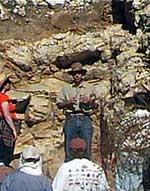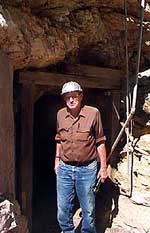|
|
RAMONA, CALIFORNIA—
"It's been four years since we've seen you," said Tony Kampf, a gemstone researcher and rock hound extraordinaire upon our arrival at the famous "Little Three Mine" near Ramona, California. In May, 1996, we had the good fortune to join Tony and other members of the Gem and Mineral Council of the Natural History Museum of Los Angeles County for a rare look inside the Himalaya mine, the site of one of the richest tourmaline deposits in the world. Today Tony is leading an intrepid group of Council members visiting a mining area near Ramona, California. The mine is now owned by Louis B. Spaulding, Jr., and it has produced some of the finest examples of orange spessartine garnet and blue topaz ever found in North America.
The name "Little Three Mine" refers to the three men who discovered the site in the early 1900's. Most of the gems found on the site were discovered by Louis Spaulding, Jr. in the mid-1970's. He says that he measured work production by the number of wheelbarrows of rock he could remove in a single day. "A 15-wheelbarrow day was a very fast day in the early years." Production of gem and specimen-quality minerals has been on a boom-or-bust cycle. "One year I made $50,000-- others weren't as good" said Louis as he led us into one of the mine shafts. Louis has a patient, professorial manner as he patiently shows rock hounds examples of the banded "line rock" that is one of the indicators that can lead to finding pockets in the pegmatites where the best gemstones are likely to be found. Pegamites are dikes of igneous rock that cut across the background country rock. Pegamites range in size from hundreds of feet thick to just a few inches. Examples of gems that can be found in pegamites can be viewed at "The Pegamite Zone".
Click here to see a specimen of blue topaz and smoky quartz discovered in the mine. The accompanying article by David Felderman also provides interesting background about other gem-producing areas of San Diego County.
Beyond the value of the gems, this mining area has served to educate several generations of geologists and mineralogists. On our tour of his mine, Louis pointed out a cluster of quartz crystals that he says "are the most student-photographed crystals in existence." A world-famous geologist, Richard Jahns, spent nearly 40 years studying the pegmatites in the area, and his work serves as the basis of much of the mineralogical study around the world. As Tony prepared to gather up his tools for his own collecting effort of the day, he mentioned that "a number of minerals were first found and indentifed here-- one of those is the sought-after pink beryl known as morganite named in honor of J.P. Morgan." Megan and I didn't make any extraordinary gem finds today, but a day spent in the sun can be its own reward. For more information contact: The Natural History Museum of Los Angeles County - Gem and Mineral Council.
Mark
10/00


